Online Gather.town Pitches
Perfusion & Permeability III
Joint Annual Meeting ISMRM-ESMRMB & ISMRT 31st Annual Meeting • 07-12 May 2022 • London, UK

| Booth # | ||||
|---|---|---|---|---|
4874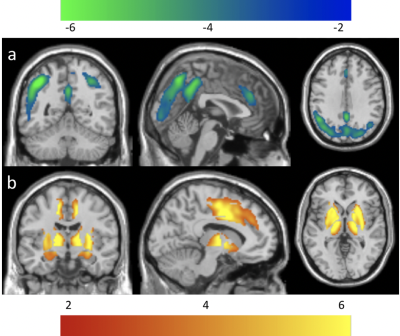 |
1 | Potential regulation of cerebral blood flow by the basal forebrain
Zongpai Zhang1, Elizabeth Riley2, Adam K. Anderson2, Eve D. DeRosa2, and Weiying Dai1
1Computer Science, State University of New York at Binghamton, Binghamton, NY, United States, 2Department of Psychology, Cornell University, Ithaca, NY, United States
The basal forebrain (BF) has a known regulatory role in the cholinergic vasodilatory system, increasing cerebral blood flow (CBF) in the cerebral cortex using animal studies. However, parallel human studies have never been performed. Thirty-three young adults and 27 older adults were tested for the aged-related changes in arterial transit time (ATT) and CBF, which were measured using arterial spin labeling (ASL). We observed the age-related CBF and ATT changes in the basal forebrain and other brain regions, which provide a foundation for investigating the regulatory role of the basal forebrain on the cholinergic vasodilatory system.
|
||
4875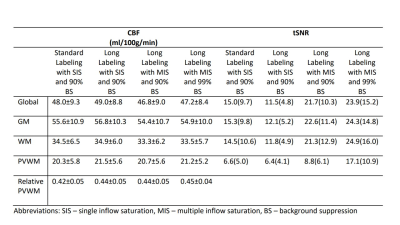 |
2 | Reliability of Periventricular White Matter Cerebral Blood Flow using Different ASL protocols
Shokufeh Sadaghiani1, William Tackett1, M. Dylan Tisdall2, John A. Detre1, and Sudipto Dolui2
1Department of Neurology, University of Pennsylvania, Philadelphia, PA, United States, 2Department of Radiology, University of Pennsylvania, Philadelphia, PA, United States
Cerebral blood flow (CBF) in periventricular white matter (PVWM) may provide a mechanistically specific biomarker of cerebral small vessel disease. We compared the reliability of PVWM CBF obtained from arterial spin labeling MRI acquired twice separated by a week, using different protocols involving standard, long labeling duration, single and multiple inflow saturation (MIS), and level of background suppression (BS), in young healthy participants. The MIS protocol with 99% BS significantly improved the temporal signal to noise ratio of the acquisition, with a subtle improvement of intersession-reliability. Reliability of PVWM CBF was of the same order as other conventional regions of interest.
|
||
4876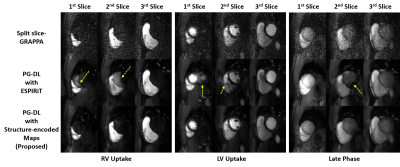 |
3 | Highly Accelerated Myocardial Perfusion Using Physics-guided Deep Learning With Structure-encoded Coil Maps
Omer Burak Demirel1,2, Burhaneddin Yaman1,2, Steen Moeller2, Sebastian Weingärtner3, and Mehmet Akçakaya1,2
1Electrical and Computer Engineering, University of Minnesota, Minneapolis, MN, United States, 2Center for Magnetic Resonance Research, University of Minnesota, Minneapolis, MN, United States, 3Department of Imaging Physics, Delft University of Technology, Delft, Netherlands
Myocardial perfusion cardiac MRI is widely used to functionally assess coronary artery disease. Although numerous acceleration techniques are used, improved spatio-temporal resolutions and coverage are desirable. Deep learning (DL) reconstruction has shown improvement over conventional reconstruction techniques at higher accelerations. Yet, SNR/contrast changes across perfusion dynamics hinder their generalization performance. In this work, we propose a multi-coil encoding operator that uses coil maps encoding structural information for physics-guided DL. This provides a uniform contrast at the network output across dynamics, leading to improved image quality compared to physics-guided DL with ESPIRiT coil maps, as well as conventional acceleration methods.
|
||
4877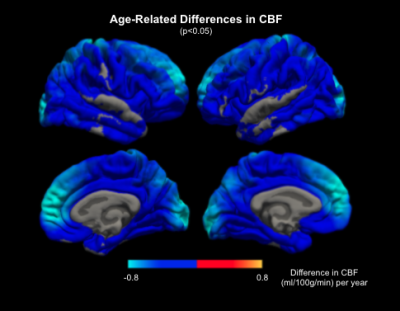 |
4 | Mapping the Age Effect on Cortical Arterial Arrival Time and Perfusion using multi-delay pCASL
Yutong Sun1, Paul T.H Chang 1, and J. Jean Chen2
1Rotman Research Institute, Baycrest Health Sciences, Toronto, ON, Canada, 2Medical Biophysics, University of Toronto, Toronto, ON, Canada
Multi-delay arterial spin labeling (ASL) has made it possible to non-invasively quantify cerebral hemodynamic changes in aging, including cerebral blood flow (CBF) and arterial arrival time (ATT). However, limited numbers of studies exist to focus on the spatial heterogeneity of age effects on both CBF and ATT. In this study, we map the relationships between age, CBF and ATT on the cerebral cortex using multi-delay pseudo-continuous ASL (pCASL) data from the Human Connectome Project in Aging.
|
||
4878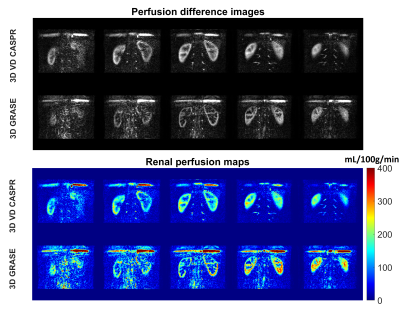 |
5 | Volumetric Renal Perfusion Imaging with pCASL – Comparison of 3D TSE and 3D GraSE Readout
Limin Zhou1, Yiming Wang1, and Ananth Madhuranthakam1,2
1Radiology, University of Texas Southwestern Medical Center, DALLAS, TX, United States, 2Advanced Imaging Research Center, University of Texas Southwestern Medical Center, DALLAS, TX, United States
Recent consensus recommended SE-EPI as the preferred readout for 2D single-slice renal perfusion imaging using pCASL. Compared to single-slice 2D acquisition, 3D acquisitions can achieve higher SNR, larger slice coverage, and optimal background suppression in similar scan times. In this study, we compared 3D GRASE, the recommended 3D readout for brain perfusion imaging, with an optimized 3D TSE readout using Cartesian acquisition with spiral profile reordering and Variable Density Sampling (VD-CASPR) in 4 healthy volunteers for volumetric renal perfusion imaging. Results showed that 3D pCASL with TSE VD-CASPR is more robust and has higher SNR than 3D pCASL with GRASE.
|
||
4879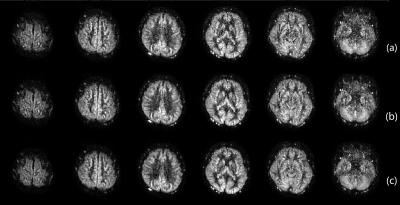 |
6 | Improving Spatial Resolution of Brain and Renal ASL MR Images using 3D Cartesian TSE and Compressed SENSE Reconstruction
Yiming Wang1, Limin Zhou1, Marco C. Pinho1,2, Ivan Pedrosa1,2,3, Joseph A. Maldjian1,2, and Ananth J. Madhuranthakam1,2
1Department of Radiology, UT Southwestern Medical Center, Dallas, TX, United States, 2Advanced Imaging Research Center, UT Southwestern Medical Center, Dallas, TX, United States, 3Department of Urology, UT Southwestern Medical Center, Dallas, TX, United States
Arterial spin labeled (ASL) MRI is often acquired at reduced spatial resolution due to lower signal to noise (SNR), although higher spatial resolution within clinically feasible scan times is desired. In this study, we applied Compressed Sensing–Sensitivity Encoding (CS-SENSE) to 3D Cartesian TSE with Variable Density (VD) sampling to achieve higher spatial resolution ASL-MRI without prolonging acquisition time. Perfusion images acquired with CS-SENSE showed good SNR and image quality in both brains and kidneys, without introducing bias to perfusion quantification. This may be particularly useful to measure perfusion changes in small-sized lesions in both brains and kidneys.
|
||
4880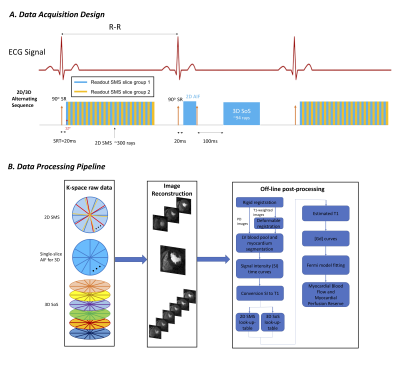 |
7 | Quantitative myocardial perfusion using whole-heart, 2D SMS and 3D sequences alternating every heartbeat
Qi Huang1,2, Jason Mendes1, Ganesh Adluru1, and Edward DiBella1
1Utah Center for Advanced Imaging Research (UCAIR), University of Utah, Salt Lake City, UT, United States, 2Biomedical Engineering, University of Utah, Salt Lake City, UT, United States
A sequence with 2D simultaneous multi-slice (SMS) and 3D stack-of-stars (SoS) alternating each heartbeat sequence has been proposed previously1. Here, we increase the heart-coverage of the 2D SMS portion of the scan from 3 slices to 6 slices, to match the coverage of the 3D SoS method. Three minipigs and one healthy volunteer were studied using this method at both adenosine stress and rest cases, and the sequences gave flows with reasonable agreement.
|
||
4881 |
8 | Customized whole-brain covering GRASE in multi-delay pCASL for distinct contrasts and adequate SNRs in hemodynamic parameter mappings
Yichen Hu1, Qing Wei2, Zhongyang Zhou2, Junpu Hu2, Jun Xie2, and Jian Xu1
1UIH America, Inc., Houston, TX, United States, 2United Imaging Healthcare, Shanghai, China
We report that manipulation of GRASE readout with SORT view-ordering in multi-delay ASL on either gradient echo trains for adjusted spatial resolutions or FSE train for modulated T2-blurring can significantly alter the perfusion hemodynamic parameter mapping contrasts among tissues and among cerebral lobes under different pathways of blood circulation, and can meanwhile regulate the SNRs of the maps. Among the performed GRASE designs, the readout with moderate spatial resolution and segmented kz is recommended for sharp GM/WM contrasts in CBF and ATT maps in conjunction with distinct contrast between anterior and posterior circulations in the ATT map, with adequate SNRs.
|
||
4882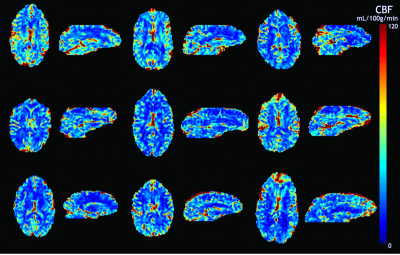 |
9 | Sinusoidal oxygen respiratory paradigm for perfusion MRI
Chau Vu1, Jian Shen1, Soyoung Choi2, Koen Baas3, and John Wood4
1Biomedical Engineering, University of Southern California, Los Angeles, CA, United States, 2Neuroscience Graduate Program, University of Southern California, Los Angeles, CA, United States, 3Amsterdam UMC, Amsterdam, Netherlands, 4University of Southern California, Los Angeles, CA, United States
Gadolinium-based Dynamic Susceptibility Contrast (DSC) MRI is a popular technique to measure brain perfusion. However, it requires the use of an invasive exogenous contrast agent which accumulates in tissue and impedes repeated measurements. To overcome the need of gadolinium injection, this study employed the noninvasive deoxygenated DSC (dDSC) technique and proposed a novel respiratory challenge paradigm which delivers a sinusoidally-modulated oxygen stimulus as an endogenous contrast to measure perfusion. We evaluated this paradigm on 10 healthy controls and compared cerebral blood flow against other perfusion MRI techniques such as gadolinium-based DSC and arterial spin labeling.
|
||
4883 |
10 | Multi-delay pCASL with optimal post-labeling delay times by incorporating ATT probability distribution improves accuracy of CBF measurement
Yining He1, Zhiyuan Zhang1, Xingfeng Shao1, Timothy Macaulay2, and Lirong Yan1
1USC Stevens Neuroimaging and Informatics Institute, Keck School of Medicine, University of Southern California, Los Angeles, CA, United States, 2Division of Biokinesiology and Physical Therapy, Ostrow School of Dentistry, University of Southern California, Los Angeles, CA, United States The accuracy of CBF measurement in multi-delay ASL relies on the design of optimal PLDs. In this study, we optimized PLDs in 3D pCASL using a previously proposed optimization framework based on the Cramer-Rao lower bound optimization by incorporating different ATT prior distributions including in-vivo Gaussian distribution and uniform distribution. Evenly spaced PLDs were also applied for comparison. Both simulation and in vivo data suggest that optimal PLDs using in vivo ATT Gaussian distribution offer the best performance in terms of the accuracy of CBF estimation. |
||
4884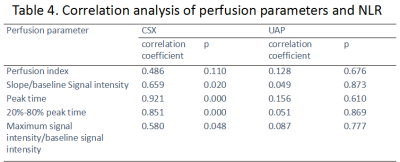 |
11 | Myocardial first-pass perfusion assessed by cardiac magnetic resonance and neutrophil to lymphocyte ratio in patients with cardiac syndrome X
Gang zhang1, Wei Xing1, Tingting Li2, Yan Zheng1, Ying Huang3, Junjing He1, and Xiuzheng Yue4
1Department of Magnetic Resonance, The First Affiliated Hospital of Henan University of CM, Zhengzhou, China, 2Department of Magnetic Resonance, The First Affiliated Hospital of Henan University of Chinese Medicine, Zhengzhou, China, 3The First Affiliated Hospital of Henan University of CM, Zhengzhou, China, 4Philips Healthcare, Zhengzhou, China
Cardiac syndrome X (CSX) is also known as microvascular angina pectoral, the pathogenesis of which has not been clearly determined [1]. A coronary angiography study [2] showed that neutrophil to lymphocyte ratio (NLR), as a marker of inflammatory response in a variety of cardiovascular diseases, was elevated in CSX patients. The NLR of CSX patients with impaired myocardial perfusion was higher than that of patients without it, such as unstable angina pectoris (UAP) patients. In this study, we found that the distribution of myocardial first-pass perfusion was heterogeneous in each segment of CSX patients in the resting stage, better than that of UAP patients. The correlation between perfusion parameters and NLR was high and significant.
|
||
4885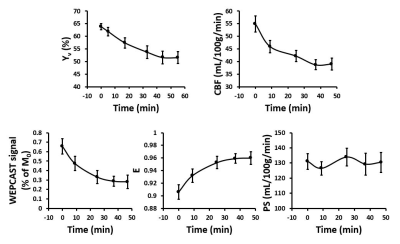 |
12 | Blood-brain barrier permeability in response to caffeine challenge
Zixuan Lin1, Dengrong Jiang1, Peiying Liu1,2, Abhay Moghekar3, and Hanzhang Lu1
1Department of Radiology, Johns Hopkins University School of Medicine, Baltimore, MD, United States, 2Department of Diagnostic Radiology and Nuclear Medicine, University of Maryland School of Medicine, Baltimore, MD, United States, 3Department of Neurology, Johns Hopkins University School of Medicine, Baltimore, MD, United States
Caffeine is known to alter brain physiology by acting as an adenosine antagonist, but its effect on the BBB permeability to water is not fully elucidated. In this study, we utilized water-extraction-with-phase-contrast-arterial-spin-tagging (WEPCAST) MRI to investigate the change of BBB permeability after caffeine challenge in young healthy adults. Results showed that after caffeine ingestion, water extraction across BBB increased as global cerebral blood flow decreased, while the BBB permeability to water remained unchanged, indicating a relative stable BBB function in response to caffeine challenge, which can be important for normal brain function.
|
||
4886 |
13 | Augmented Perfusion Quantified by MRI Depends on Collateral Recruitment in Middle Cerebral Artery Occlusion: A Pilot Study
Mira Liu1, Niloufar Saadat1, Yong Jeong1, Steven Roth2, Marek Niekrasz1, Gregory Christoforidis1, and Timothy Carroll1
1University of Chicago, Chicago, IL, United States, 2University of Illinois, Chicago, IL, United States
We have developed an experimental model and quantitative MRI biomarkers to quantify the effects of therapeutic intervention to enhance collateralization in acute stroke. We performed controlled experiments in a pre-clinical canine model of ischemic stroke and use quantitative cerebral MR perfusion with DSC, intravoxel incoherent motion (IVIM), and neutron capture microsphere deposition, x-ray angiography for collateralization, and MR diffusion imaging for infarction to demonstrate a significant increase in perfusion and decrease in infarct growth in the hyperacute phase of an ischemic stroke.
|
||
4887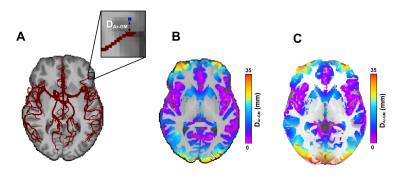 |
14 | MR measures of regional cerebral blood flow and cortical thickness are tightly linked to the proximity of large cerebral arteries
Samantha Cote1, Marco Perez Caceres1, Felix Dumais1, Jean-Francois Lepage1, and Kevin Whittingstall1
1Université de Sherbrooke, Sherbrooke, QC, Canada
Using time of flight magnetic resonance angiography, we explored how local variations in cerebral arterial morphology are related to cerebral blood flow (CBF) and cortical thickness (CT). We observed a significant, negative relationship between the proximity of a region of interest to an artery and CBF and CT such that regions proximal to large arteries have higher CBF and CT. These results highlight the importance of considering underlying cerebral vasculature when studying the human brain using MRI as it can lead to significant biases in commonly employed metrics.
|
||
The International Society for Magnetic Resonance in Medicine is accredited by the Accreditation Council for Continuing Medical Education to provide continuing medical education for physicians.